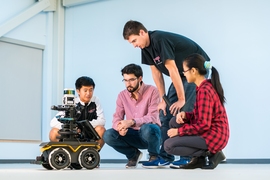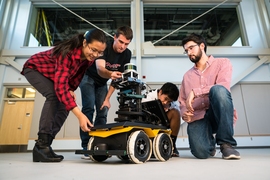Rose Wang loves to work on projects — especially ones that exceed the bounds of her declared majors, economics and computer science. She thrives on do-it-yourself design solutions. Her latest involves making an aerodynamic drone. “We’ll see how that goes,” she says.
So when Wang spotted a campus poster about a new project-centric program, the New Engineering Education Transformation (NEET), she went all in. She is among MIT’s 45 second-year students engaged in a pilot educational initiative that has the potential to re-engineer engineering education.
When Wang and her cohort enrolled in NEET this autumn, they chose to make interdisciplinary projects the guiding force in their undergraduate experience. There are two pilot cross-departmental threads: Living Machines and Autonomous Machines. Engineering students choose one, and their classes and advising are tailored to meet the needs of the thread.
Working together on a string of projects from sophomore through senior year, students produce all sorts of “machines” — a word encapsulating all things engineers build, including mechanical, informational, molecular, biological, computational, and energetic constructs.
“This is an opportunity to expand the student experience,” says Anette “Peko” Hosoi, MIT’s associate dean of engineering and a faculty co-lead in the development of NEET. She says the curriculum will lead to student engagement with many departments, the acquisition of interpersonal and professional skills, and exposure in areas likely to be in demand after graduation.
“We’re targeting MIT education at the industries of the future rather than industries of the past,” says Hosoi, who is also the Neil and Jane Pappalardo Professor of Mechanical Engineering.
“Most important projects in industry today are done by large interdisciplinary groups,” she says. “This prepares students for that environment.”
Industry calling
These industry trends are not lost on MIT students, according to Mitchell Guillaume, a mechanical engineering student enrolled in NEET. “I want to have the skills to solve the problems that don’t exist yet,” Guillaume says. “That way, when the problems of the future arrive, I can be among the first to pioneer solutions.”
A similar desire inspired Jasper Haag, who is majoring in electrical engineering and computer science. “In my opinion, this program sets me up for success when I graduate. I will already have experience and ideas about what I want to do with my skill set.”
Indeed, Haag adds, traditional engineering curricula really need updating. “I’ve always found the plain academics focused on at MIT and elsewhere don’t provide adequate experience and insight into the technologies that will be relevant in my future work.”
For Haag, a solution has arrived. “With NEET our aim is to rethink engineering education — what and how students learn — in a fundamental way across the school,” says Edward Crawley, the Ford Professor of Engineering in the Department of Aeronautics and Astronautics and faculty co-lead in the development of NEET.
MIT has a long history of innovative thinking in engineering education, he adds. The Institute was founded on “useful knowledge” in 1861. And the introduction of the sciences into the curriculum in the 1930s represented a deliberate step to keep all of MIT’s education programs based on fundamental principles.
“MIT has flourished because it’s willing to make bold advances,” Crawley says.
Living Machines
Standing before a chalkboard, Eric Alm, a professor of biological engineering at MIT and co-director of the Center for Microbiome Informatics and Therapeutics, speaks in an excited tone about the project ahead. “The gut on a chip is the ‘living machine’ we’re going to build,” he says.
Living Machines is a cross-departmental NEET thread offered jointly by the departments of Biological Engineering, Mechanical Engineering, and Chemical Engineering. Alm is co-lead of the thread together with Linda Griffith, the School of Engineering Professor of Teaching Innovation, Biological Engineering, and Mechanical Engineering.
“Why are we building it? What I’d like to do today is give you the big picture,” says Alm, a specialist in engineering the human microbiome — the collection of microorganisms that live in and on our bodies.
Second-year student Aya Halawi nods. She is excited by the mission but equally so by the process of working with people from other disciplines on “a big project.”
As the class gets underway, Halawi, a biological engineering major, whispers: “This feels more like what we’ll be doing in the real world.”
All eyes are on Alm as he explains more: “Why even have a gut on a chip? The short answer is because it’s one of the best models for human disease that we have.”
Ultimately, students will bring new technologies and new ways of thinking into a final project on the microbiome that will be on the cutting edge, he says.
Outside of class, Rebekah Costello, a second-year student in biological engineering, says she is fascinated by the microbiome. She is also aware NEET offers professional advantages. “I’ll meet faculty, and working on such an exciting field like the microbiome will be good for industry opportunities.”
Autonomous Machines
For Albert Go, Autonomous Machines offers the best of all worlds. The thread, which is led by Jonathan How, the Richard Cockburn Maclaurin Professor of Aeronautics and Astronautics, is offered jointly by the departments of Aeronautics and Astronautics, Mechanical Engineering, and Electrical Engineering and Computer Science.
Go calls it “a bridge to my passions.” He and the rest of the students in the thread will focus on building mechanical systems, software, and autonomy algorithms for real-world robots. “This is the best way to learn,” he says. “I like real-world application, and learning from my peers. With the projects, I’m excited to see what I’m learning about come to life.”
EECS major Gloria Fang says Autonomous Machines appealed to her because it involves hands-on projects, earning a NEET certificate, and still pursuing her majors as planned. “I wanted to experience other majors but I didn’t have time to fit more classes into my schedule,” she says.
Interdisciplinary seminars and projects in NEET provide a solution. “I’m looking forward to exploring how computer science relates to other fields.” Not to mention, Fang adds: “I feel like this program will open up job opportunities.”
And as for project-loving Wang, she says NEET is proving the right fit. “I mean, making an autonomous machine or a car just sounds really great. How do you beat that?”












